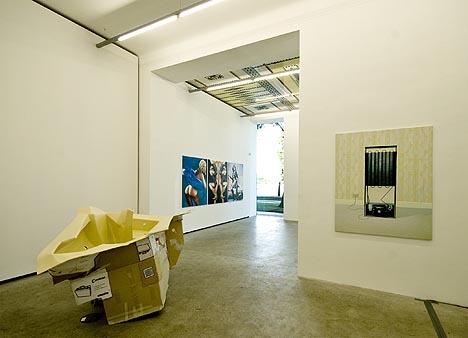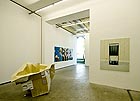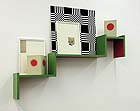
translated and summarized by: Liz Wollner-Grandville,
English summary June 7 - 13
BAWAG Contemporary
Mike Bouchet – Retreat
07.05.10 – 30.06.10
Battered world of goods
Aggression is clearly evident here. But who is being attacked? Based on the chaos one is confronted with, the artist Mike Bouchet plays the role of the destroyer. But it could just as well be self-defence. Against an economy, which usually heads towards destruction. But the fractures that Bouchet leaves behind in his – visual – language only have a semantic nature. For example when he transforms an indoor golf course into a battlefield of broken golf clubs and scattered balls in the new Kunstraum of the BAWAG Contemporary.
Partly driven by irony, partly by Cynic aggression he unveils the policies underlying the world of goods. He devotes himself to the texture of life-style and consumer culture. Homemade hamburgers mould away in seductively lustrous CANBURGER cans. The Californian born artist, who lives and works in Frankfurt, questions the structure of value-creation processes. Generally they are based on the density of symbolic semblances. The era of practical value is long gone.
Bouchet caricatures diverse gimmickries of the so-called wellness society; such as one of their class symbols: the Jacuzzi. This was already the central theme of his exhibition at the Kunstraum Innsbruck in 2005. Jacuzzis, made of carton and polyester fibreglass, twisted, wrinkled and practically useless, named after superfluous characters such as Berlusconi or Lionel Ritchie, must be interpreted as deconstructions. Bouchet is in perfect command of the ars combinatorial of contemporary art, but exhibits all of this with almost too much routine. The BAWAG Contemporary presents his sketches and construction drawings as well as his paintings, which remind of advertisement messages. And the Jacuzzis – the most interesting works. And the golf chaos. As a room installation. Ironically sponsored by Nike. On the sideline - a battered nude made of oak whose wooden surface was badly beaten by golf clubs.
With Bouchet’s solo exhibit the BAWAG Contemporary also presents its new exhibition space, which is currently one of the most impressive locations for mid-format exhibits in Vienna. The venue consists of two different room formations spanned between Wiesingerstrasse and the Franz Josefs Kai, connected by a glass-roofed courtyard. A bridge provides the passage from the exhibition area to the office and ancillary rooms. Wide open and intimate situations - with open space facing the street as well as protected areas in the cellar being available for presenting large, established, relevant positions in unexpected, special solo exhibits as well as offering emerging artists opportunities to show their work before they attain international stardom. One may look forward to the next program, as well as to Mike Bouchet’s solo exhibit in the Schirn Kunsthalle in Frankfurt, starting July 1, where he will focus on the myth of the one-family home in line with his floating one-family-house presented at the last Venice Biennial.
By Roland Schöny
Bawag Contemporary
1010 Vienna, Franz Josefs Kai 3
www.bawagcontemporary.at
Startgalerie im Museum auf Abruf
Ekaterina Shapiro-Obermair – Salon Systématique
21.05.10 – 17.06.10
Russian Avant-garde
Amazing how the works by this young artist, born 1980, remind of the classic Avant-garde of the 1920’s and 30’s without appearing antiquated. Especially the collages strike one as originals of that time: they each show a small black-and-white photo reminding of Man Ray’s works, skilfully positioned on a white piece of paper. The eccentric but subtle choice of how the photos are positioned and their integration into the configured plane with the help of a single fine line lets the works resemble constructivist compositional studies, whose quality equals that of Rodchenko or Malevich.
The freestanding assemblages are characterized by clear, reduced, geometrical forms. Some of th stair- and box-like sculptures made of painted plywood and fibreboards are placed on four upside down glasses, and appear as if floating, and some are positioned directly on the floor. The black-and-white works with their geometric patterns are especially striking. Their design is not only in line with early 20th century art but also with the 1960’s and 70’s Op Art. Their fractured image- and form language is bizarre, creating a distancing effect, which embeds Shapiro-Obermair’s works in today’s postmodernism.
The artist's work focuses on Russian art and culture and the current presentation very often reminds of the Russian Avant-garde and its characteristic form language.
By Wolfgang Pichler
Startgalerie im Museum auf Abruf
1010 Vienna, Felderstrasse 6-8, next to the town hall
www.musa.at
Kunsthalle Tübingen
Karin Kneffel 1990 – 2010
01.05.10 – 11.07.10
Brainteaser on canvas
In the mid-90’s, the opulence of those large-format works made one’s eyes pop out: cherries hanging seductively from branches, velvety lustrous peaches - and one was tempted to reach out for prunes, apples or grapes. And small square-shaped animal portraits, almost physiognomic studies. There were groups of distant views of snowy mountaintops and close-ups of blazing fires, and later there were floors with and without carpets, and at some point one had the feeling that Karin Kneffel’s work has become somewhat flat or platitudinal. Currently, the Kunsthalle Tübingen is presenting Kneffel’s works from 1990 to 2010, and it becomes clear that her work is anything but banal.
In an interview published in the exhibition catalogue (Hatje Cantz) the former master scholar of Gerhard Richter said: “No, I have not doubts regarding sensuality; of the reality of a sensuous appearance. I create pictorial spaces. And in these spaces I have to solve everything. My work always deals with the inherent distance to reality. I want to depict reality, distance in the artistic presentation, and ultimately use it to transform. Everything within the painting must be reasonable.”
And it is this reasonableness that places obstacles in the way of perception. The free view onto an artistic interior is disturbed by drops of water on a windowpane, which transform themselves into abstract spots on a realistic painting, a Dalmatian’s mirror image on a shiny floor glances attentively from the canvas, while the animal is comfortably lying on the floor.
Among the paintings, the majority of which are devoid of any people, a small eight-part work created in 2005 catches one’s eye. Maybe the depiction of the Homo sapiens is below the artist’s usual technical abilities, but the coming and going of the people wading through the water transforms itself wonderfully into a kind of loop on canvas. Alone this makes it worthwhile to take a look at the rest of her not at all commonplace oeuvre.
By Daniela Gregori
Kunsthalle Tübingen
72076 Tübingen, Philosphenweg 76
www.kunsthalle-tuebingen.de
Mehr Texte von translated and summarized by: Liz Wollner-Grandville


 Teilen
Teilen



